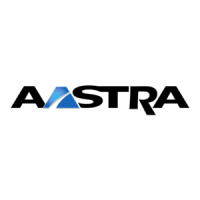Planning
33
Planning Aastra 400 DECT systems as of R1.0
syd-0457/1.0 – R1.0 – 10.2012
5. 2 Initial rough determination of the radio unit locations
Radio circumstances are difficult to estimate. For this reason, situations regarded as
particularly critical need to be determined on site through measurements. This will
provide a reliable idea of the equipment required and the locations for the radio
units.
The following rules of thumb may be of help:
• Good connections still possible in a horizontal direction behind 2...3 ordinary
brick walls; barely any penetration through concrete floors and ceilings in a ver-
tical direction and in ground floor or basement floors, i.e. each storey must be
supplied separately. A certain amount of vertical penetration can be expected
from the first floor upwards; generally speaking, radio propagation conditions
improve as the distance from the ground increases.
• Openings in obstacles improve radio conditions.
• Subsequent furnishing: In empty buildings, the effect of the absence of furni-
ture, machines, partitions, etc., and their room limitation needs to be taken into
account. Subsequent extensions and conversions also have an influence.
• It is important to ensure sufficiently large overlap zones between neighbouring
coverage ranges. The signal should not be too weak that it prevents automatic
handover to the next radio unit. Here, it is necessary to find a solution between a
large number of radio units and a reasonable coverage of the premises.
• Radio range (guideline values)
– up to 30 m in buildings
– outdoors up to 250 m.
Radio Unit Distances to the communication server
Take note when planning that with distances up to 600 m the power supply can be
provided as of the DSI bus. From 600 m to maximum 1200 m, the radio unit and
communication server diameter and hardware version determine the line length
from which a local power supply with plug-in power supply unit is required. If this
is the case, a 230 VAC connection must be provided. (For more information, see the
chapter "DSI terminal interface" in the Aastra 415/430 or Aastra 470 System Man-
ual.)
Tip:
Radio units with < 600 m line lengths can also be powered locally to
relieve the communication server's power supply to the terminals. This
can also render the use of an auxiliary power suply unit superfluous.

